Parametric Assessment of Soil Nailing on the Stability of Slopes Using Numerical Approach
Abstract
1. Introduction
2. Materials and Methods
2.1. Soil
2.2. Finite Element (FE) Model
2.3. Calculation of FS
3. Results and Discussion
3.1. Stability Analysis of Unreinforced Slopes
3.2. Effect of Nail Inclination
3.3. Influence of Nail Length
3.4. Effect of Vertical Nail Spacing
3.5. Nail Forces
3.6. Influence of Slope Height and Soil Property
3.7. Model Comparison and Verification
3.8. Optimum Nail Layout
3.9. Wall Facing
4. Conclusions
- For a horizontal backslope, the optimum nail inclinations for β = 45°, 60°, 75°, and 90° are 25°, 20°, 10–15°, and 0°, respectively. For a backslope of 10°, the optimum nail inclinations for β = 45°, 60°, 75°, and 90° are 30°, 25°, and 15–20°, whereas for a backslope with 20°, the optimum nail inclinations for β = 45°, 60°, 75°, and 90° are 30°, 30°, 20°, and 0° respectively. Moreover, the importance of selecting an optimum nail inclination is understood through failure surface observation from FE analysis.
- With the increase in the value of L/H, FS is found to increase for all the slope angles, and the percent increase in FS varies within 23–63% depending on L/H and the slope angle. FS increases rapidly with the increase in values of L/H up to 0.9, and beyond that the increase in nail length increases FS by only 1.7–4.3%. Therefore, the optimum nail length is chosen as 0.9 times the height of the slope.
- With the decrease in the vertical spacing of the nail, FS is found to increase, and the maximum FS is found for a vertical spacing of 1.25 m. Although reduced vertical spacing improves the FS of slopes, the difference in FS for the spacing of 1.25 m and 2.0 m varies within 9–17%. Considering the economy and ease of construction, a vertical nail spacing of 1.50 m can be selected as the optimum nail vertical spacing.
- The axial force entering the nail increases with the increase in slope and backslope angle. For all the cases, the bottom nail is found to experience a maximum tensile force, whereas the minimum tensile force is observed in the topmost nail.
- An optimum nail layout has been proposed for similar soil types and slope geometries. The inclusion of soil nails with the optimum layout can increase FS by 29–75%.
Author Contributions
Funding
Institutional Review Board Statement
Informed Consent Statement
Data Availability Statement
Acknowledgments
Conflicts of Interest
References
- Fan, C.C.; Luo, J.H. Numerical study on the optimum layout of soil–nailed slopes. Comput. Geotech. 2008, 35, 585–599. [Google Scholar] [CrossRef]
- Rawat, S.; Zodinpuii, R.; Manna, B.; Sharma, G. Investigation on failure mechanism of nailed slopes under surcharge loading: Testing and analysis. Geomech. Geoengin. 2013, 9, 18–35. [Google Scholar] [CrossRef]
- Jaiswal, S.; Srivastava, A.; Chauhan, V.B. Numerical Modeling of Soil-Nailed Slope Using Drucker–Prager Model. In Advances in Geo-Science and Geo-Structures; Lecture Notes in Civil Engineering; Choudhary, A.K., Mondal, S., Metya, S., Babu, G.L.S., Eds.; Springer: Singapore, 2022; Volume 154. [Google Scholar] [CrossRef]
- Lin, H.; Xiong, W.; Cao, P. Stability of soil nailed slope using strength reduction method. Eur. J. Environ. Civ. Eng. 2013, 17, 872–885. [Google Scholar] [CrossRef]
- Pandey, A.; Jaiswal, S.; Chauhan, V.B. Numerical Studies on the Behavior of Slope Reinforced with Soil Nails. In Local Site Effects and Ground Failures; Lecture Notes in Civil Engineering; Sitharam, T.G., Jakka, R., Govindaraju, L., Eds.; Springer: Singapore, 2021; Volume 117. [Google Scholar] [CrossRef]
- Zhang, G.; Cao, J.; Wang, L. Failure behavior and mechanism of slopes reinforced using soil nail wall under various loading conditions. Soils Found. 2014, 54, 1175–1187. [Google Scholar] [CrossRef]
- Rotte, V.; Viswanadham, B.; Chourasia, D. Influence of slope geometry and nail parameters on the stability of soil-nailed slopes. Int. J. Geotech. Eng. 2011, 5, 267–281. [Google Scholar] [CrossRef]
- Menkiti, C.O.; Long, M.; Milligan, G.W.E.; Higgins, P. Soil Nailing in Dublin Boulder Clay. Geotech. Geol. Eng. 2014, 32, 1427–1438. [Google Scholar] [CrossRef]
- Chen, X.; Ren, J.; Liu, J. Analysis of Slope Stability and Software Development Based on Single-Grid and Two-Grid Finite Element Methods. Geotech. Geol. Eng. 2017, 35, 1369–1382. [Google Scholar] [CrossRef]
- Elahi, T.E.; Islam, M.A.; Islam, M.S. Effect of vegetation and nailing for prevention of landslides in Rangamati. In Proceedings of the International Conference on Disaster Risk Management, Dhaka, Bangladesh, 12–14 January 2019; pp. 193–197. [Google Scholar]
- Alejano, L.; Ferrero, A.; Ramírez-Oyanguren, P.; Fernández, M. Comparison of limit-equilibrium, numerical and physical models of wall slope stability. Int. J. Rock Mech. Min. Sci. 2011, 48, 16–26. [Google Scholar] [CrossRef]
- Cheng, Y.M.; Zhu, L.J. Unified formulation for two-dimensional slope stability analysis and limitations in factor of safety determination. Soils Found. 2004, 44, 121–127. [Google Scholar] [CrossRef]
- Zhou, X.P.; Cheng, H. Analysis of stability of three-dimensional slopes using the rigorous limit equilibrium method. Eng. Geol. 2013, 160, 21–33. [Google Scholar] [CrossRef]
- Zhu, D.Y.; Lee, C.F.; Jiang, H.D. Generalised framework of limit equilibrium methods for slope stability analysis. Geotechnique 2003, 53, 377–395. [Google Scholar] [CrossRef]
- Chen, Z.; Wang, X.; Haberfield, C.; Yin, J.H.; Wang, Y. A three dimensional slope stability analysis method using the upper bound theorem: Part II: Numerical approaches, applications and extensions. Int. J. Rock Mech. Min. Sci. 2001, 38, 379–397. [Google Scholar] [CrossRef]
- Loukidis, D.; Bandini, P.; Salgado, R. Stability of seismically loaded slopes using limit analysis. Geotechnique 2003, 53, 463–480. [Google Scholar] [CrossRef]
- Islam, M.A.; Jeet, A.A.; Gupta, N.; Gupta, A.; Islam, T. Factors Affecting the Stability and Behavior of an MSE Wall: A Numerical Approach. In Proceedings of the Geo-Congress 2022, Charlotte, NC, USA, 20–23 March 2022; pp. 375–385. [Google Scholar]
- Pak, A.; Maleki, J.; Aghakhani, N.; Yousefi, M. Numerical investigation of stability of deep excavations supported by soil-nailing method. Geomech. Geoengin. 2019, 16, 434–451. [Google Scholar] [CrossRef]
- Unterreiner, P.; Benhamida, B.; Schlosser, F. Finite element modelling of the construction of a full-scale expexperimental soil-nailed wall. Proc. Inst. Civ. Eng.-Ground Improv. 1997, 1, 1–8. [Google Scholar] [CrossRef]
- Babu, S.G.L.; Murthy, S.B.R.; Srinivas, A. Analysis of construction factors influencing the behaviour of soil-nailed earth retaining walls. Proc. Inst. Civ. Eng.-Ground Improv. 2002, 6, 137–143. [Google Scholar] [CrossRef]
- Cheuk, C.Y.; Ng, C.W.W.; Sun, H.W. Numerical experiments of soil nails in loose fill slopes subjected to rainfall infiltration effects. Comput. Geotech. 2005, 32, 290–303. [Google Scholar] [CrossRef]
- Xiao, Y.; Zhao, M.; Zhang, R.; Zhao, H. Undrained Bearing Capacity of Strip Footings Placed Adjacent to Two-Layered Slopes. Int. J. Geomech. 2019, 19, 06019014. [Google Scholar] [CrossRef]
- Wu, G.; Zhao, H.; Zhao, M.; Xiao, Y. Undrained seismic bearing capacity of strip footings lying on two-layered slopes. Comput. Geotech. 2020, 122, 103539. [Google Scholar] [CrossRef]
- Wu, G.; Zhang, R.; Zhao, M.; Zhao, S. Undrained stability analysis of eccentrically loaded strip footing lying on layered slope by finite element limit analysis. Comput. Geotech. 2020, 123, 103600. [Google Scholar] [CrossRef]
- Wu, G.; Zhao, M.; Zhang, R.; Lei, M. Ultimate Bearing Capacity of Strip Footings on Hoek–Brown Rock Slopes Using Adaptive Finite Element Limit Analysis. Rock Mech. Rock Eng. 2021, 54, 1621–1628. [Google Scholar] [CrossRef]
- Wu, G.; Eeri, M.; Zhao, M.; Zhao, H. Undrained seismic bearing capacity of strip footings horizontally embedded in two-layered slopes. Earthq. Spectra 2020, 37, 637–651. [Google Scholar] [CrossRef]
- Mohamed, A. Design Charts for Soil Nailing. Master’s Thesis, Shobra Benha University, Cairo, Egypt, 2010. [Google Scholar]
- Maula, B.H.; Zhang, L. Assessment of embankment factor safety using two commercially available programs in slope stability analysis. Procedia Eng. 2011, 14, 559–566. [Google Scholar] [CrossRef][Green Version]
- Hashemi, H.; Naeimifar, I.; Uromeihy, A.; Yasrobi, S. Evaluation of Rock Nail Wall Performance in Jointed Rock Using Numerical Method. Geotech. Geol. Eng. 2015, 33, 593–607. [Google Scholar] [CrossRef]
- Islam, M.A.; Zaman, M.N.; Badhon, F.F.; Bhandari, P.; Hossain, M.S. Numerical modeling of recycled plastic pin reinforced embankment over soft soils. In Proceedings of the International Foundations Congress & Equipment Expo 2021, Dallas, TX, USA, 10–14 May 2021. [Google Scholar]
- Wong, I.H.; Low, B.K.; Pang, P.Y.; Raju, G.V.R. Field performance of nailed soil wall in residual soil. J. Perform. Constr. Facil. 1997, 11, 105–112. [Google Scholar] [CrossRef]
- Ghareh, S. Parametric assessment of soil-nailing retaining structures in cohesive and cohesionless soils. Measurement 2015, 73, 341–351. [Google Scholar] [CrossRef]
- Maleki, M.R.; Mahyar, M. Effect of nail characteristics on slope stability based on limit equilibrium and numerical methods. Geomech. Geoengin. 2012, 7, 197–207. [Google Scholar] [CrossRef]
- Mittal, S. Soil nailing application in erosion control-An experimental study. Geotech. Geol. Eng. 2006, 24, 675–688. [Google Scholar] [CrossRef]
- Patra, C.R.; Basudhar, P.K. Optimum design of nailed soil slopes. Geotech. Geol. Eng. 2005, 23, 273–296. [Google Scholar] [CrossRef]
- Rawat, S.; Gupta, A.K.; Kumar, A. Pullout of soil nail with circular discs: A three-dimensional finite element analysis. J. Rock Mech. Geotech. Eng. 2017, 9, 967–980. [Google Scholar] [CrossRef]
- Sabhahit, N.; Basudhar, P.K.; Madhav, M.R. A generalized procedure for the optimum design of nailed soil slopes. Int. J. Numer. Anal. Methods Geomech. 1995, 19, 437–452. [Google Scholar] [CrossRef]
- Tang, O.L.; Jiang, Q.M. Stability Analysis of Slope under Different Soil Nailing Parameters Based on the GeoStudio. Int. J. Georesour. Environ.–IJGE 2015, 1, 88–92. [Google Scholar] [CrossRef][Green Version]
- Gunawan, I.; Surjandari, N.S.; Purwana, Y.M. The study on length and diameter ratio of nail as preliminary design for slope stabilization. J. Phys. Conf. Ser. 2017, 909, 012073. [Google Scholar] [CrossRef]
- Tei, K.; Taylor, R.N.; Milligan, G.W.E. Centrifuge Model Tests of Nailed Soil Slopes. Soils Found. 1998, 38, 165–177. [Google Scholar] [CrossRef]
- Zhang, J.; Pu, J.; Zhang, M.; Qiu, T. Model tests by centrifuge of soil nail reinforcements. J. Test. Eval. 2001, 29, 315–328. [Google Scholar]
- Pradhan, B.; Tham, L.G.; Yue, Z.Q.; Junaideen, S.M.; Lee, C.F. Soil-Nail Pullout Interaction in Loose Fill Materials. Int. J. Geomech. 2006, 6, 238–247. [Google Scholar] [CrossRef]
- Wu, D.; Wang, P.; Liu, G.Q. Influence of C and φ values on slope supporting by soil nailing wall in thick miscellaneous fill site. Adv. Mater. Res. 2013, 706, 504–507. [Google Scholar] [CrossRef]
- Singh, V.P.; Babu, G.L.S. 2D Numerical simulations of soil nail walls. Geotech. Geol. Eng. 2010, 28, 299–309. [Google Scholar] [CrossRef]
- Rawat, S.; Gupta, A.K. Analysis of a Nailed Soil Slope Using Limit Equilibrium and Finite Element Methods. Int. J. Geosynth. Ground Eng. 2016, 2, 34. [Google Scholar] [CrossRef][Green Version]
- Cheng, Y.M.; Au, S.K.; Pearson, A.M.; Li, N. An innovative Geonail system for soft ground stabilization. Soils Found. 2013, 53, 282–298. [Google Scholar] [CrossRef]
- Sharma, A.; Ramkrishnan, R. Parametric Optimization and Multi-regression Analysis for Soil Nailing Using Numerical Approaches. Geotech. Geol. Eng. 2020, 38, 3505–3523. [Google Scholar] [CrossRef]
- Islam, M.A. Measures for Landslide Prevention in Chittagong Hill Tracts of Bangladesh. Master’s Thesis, Department of Civil Engineering, Bangladesh University of Engineering and Technology, Dhaka, Bangladesh, 2018. [Google Scholar]
- Elahi, T.E. Effectiveness of Nailing and Vegetation for Protection of Landslides in Chittagong Hill Tracts of Bangladesh. Bachelor’s Thesis, Department of Civil Engineering, Bangladesh University of Engineering and Technology, Dhaka, Bangladesh, 2018. [Google Scholar]
- Islam, M.A.; Islam, M.S.; Elahi, T.E. Effectiveness of vetiver grass on stabilizing hill slopes: A numerical approach. In Engineering, Monitoring, and Management of Geotechnical Infrastructure, Proceedings of the Geo-Congress 2020, Minneapolis, MI, USA, 25–28 February 2020; American Society of Civil Engineers: Reston, VA, USA, 2020; pp. 106–115. [Google Scholar]
- ASTM C 136/C 136M-14; Standard Test Method for Sieve Analysis of Fine and Coarse Aggregates. ASTM International: West Conshohocken, PA, USA, 2014.
- ASTM D 854-14; Standard Test Methods for Specific Gravity of Soil Solids by Water Pycnometer. ASTM International: West Conshohocken, PA, USA, 2012.
- ASTM D 4318-17e1; Standard Test Methods for Liquid Limit, Plastic Limit, and Plasticity Index of Soils. ASTM International: West Conshohocken, PA, USA, 2017.
- ASTM D3080/D3080M-11; Standard Test Method for Direct Shear Test of Soils Under Consolidated Drained Conditions. ASTM International: West Conshohocken, PA, USA, 2011.
- Bowles, J.E. Foundation Analysis and Design; McGraw-Hill: New York, NY, USA, 1996. [Google Scholar]
- Elahi, T.E.; Islam, M.A.; Islam, M.S. Stability analysis of selected hill slopes of Rangamati. In Proceedings of the 4th International Conference on Advances in Civil Engineering 2018 (ICACE 2018), Chittagong, Bangladesh, 19–21 December 2018; pp. 307–312. [Google Scholar]
- Jaiswal, S.; Chauhan, V.B. Influence of secondary reinforcement layers to enhance the stability of steep soil slope under earthquake loading. Arab. J. Geosci. 2022, 15, 1095. [Google Scholar] [CrossRef]
- Jaiswal, S.; Chauhan, V.B. Evaluation of Optimal Design Parameters of the Geogrid Reinforced Foundation with Wraparound Ends Using Adaptive FEM. Int. J. Geosynth. Ground Eng. 2021, 7, 77. [Google Scholar] [CrossRef]
- Islam, A.; Islam, M.S.; Jeet, A.A. A Geotechnical Investigation of 2017 Chattogram Landslides. Geosciences 2021, 11, 337. [Google Scholar] [CrossRef]
- Chu, L.M.; Yin, J.H. A Laboratory device to test the pullout behavior of soil nails. Geotech. Test. J. 2005, 28, 499–513. [Google Scholar]
- Jewell, R.A.; Pedley, M.J. Analysis for soil reinforcement with bending stiffness. J. Geotech. Eng. 1992, 18, 1505–1528. [Google Scholar] [CrossRef]
- Juran, I.; Baudrand, G.; Farrag, K.; Elias, V. Kinematical limit analysis for design of soil-nailed structures. J. Geotech. Eng. 1990, 116, 55–72. [Google Scholar] [CrossRef]
- Mittal, S.; Biswas, A.K. River bank erosion control by soil nailing. Geotech. Geol. Eng. 2006, 24, 1821–1833. [Google Scholar] [CrossRef]
- Lazarte, C.A.; Robinson, H.; Gómez, J.E.; Baxter, A.; Cadden, A.; Berg, R. Soil Nail Walls Reference Manual; No. FHWA-NHI-14-007; U.S. Department of Transportation Federal Highway Administration: Washington, DC, USA, 2015.
- Islam, M.S.; Islam, M.A. Reduction of landslide risk and water-logging using vegetation. E3S Web Conf. 2018, 65, 06003. [Google Scholar] [CrossRef]
- Badhon, F.F.; Islam, M.S.; Islam, M.A. Contribution of Vetiver Root on the Improvement of Slope Stability. Indian Geotech. J. 2021, 51, 829–840. [Google Scholar] [CrossRef]
- Islam, M.A.; Islam, M.S.; Chowdhury, M.; Badhon, F.F. Influence of vetiver grass (Chrysopogon zizanioides) on infiltration and erosion control of hill slopes under simulated extreme rainfall condition in Bangladesh. Arab. J. Geosci. 2021, 14, 119. [Google Scholar] [CrossRef]
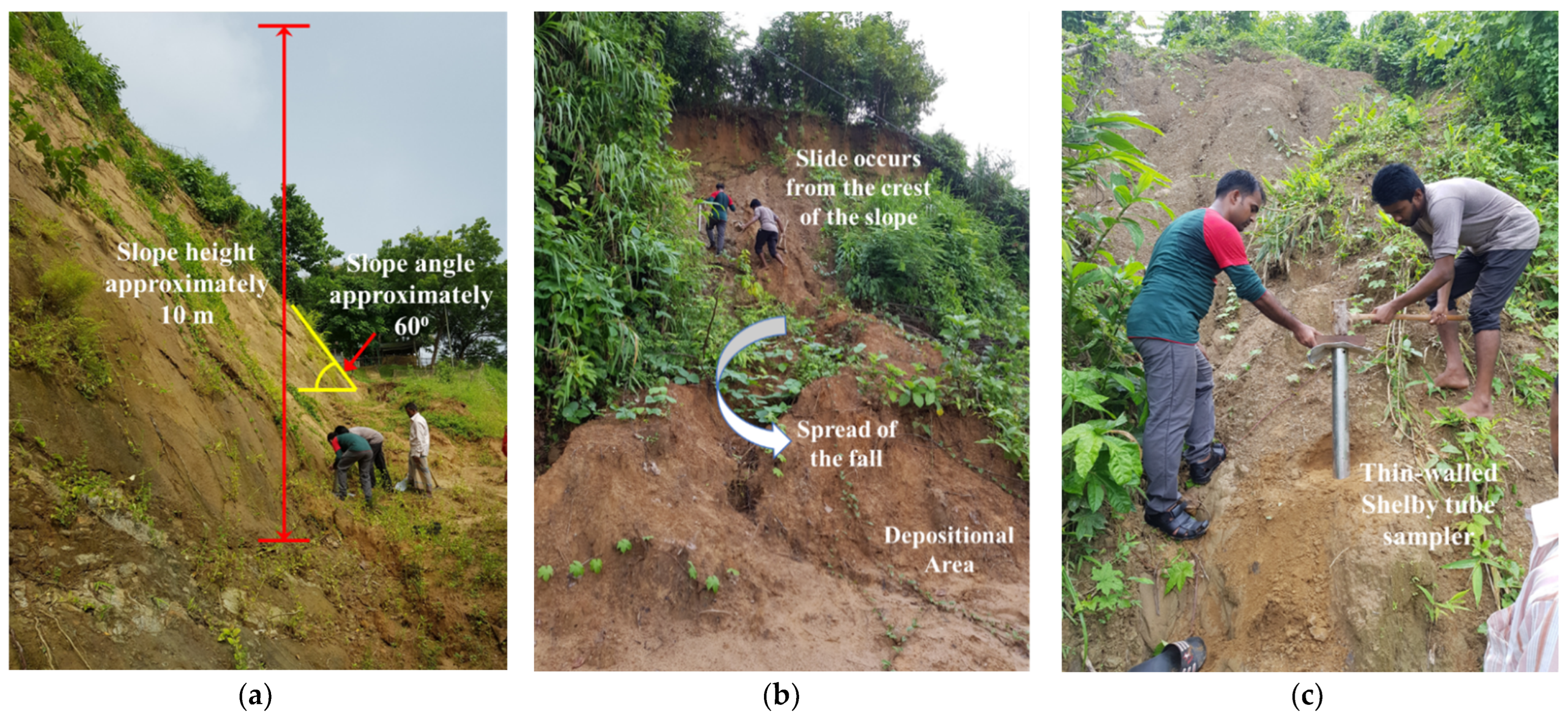
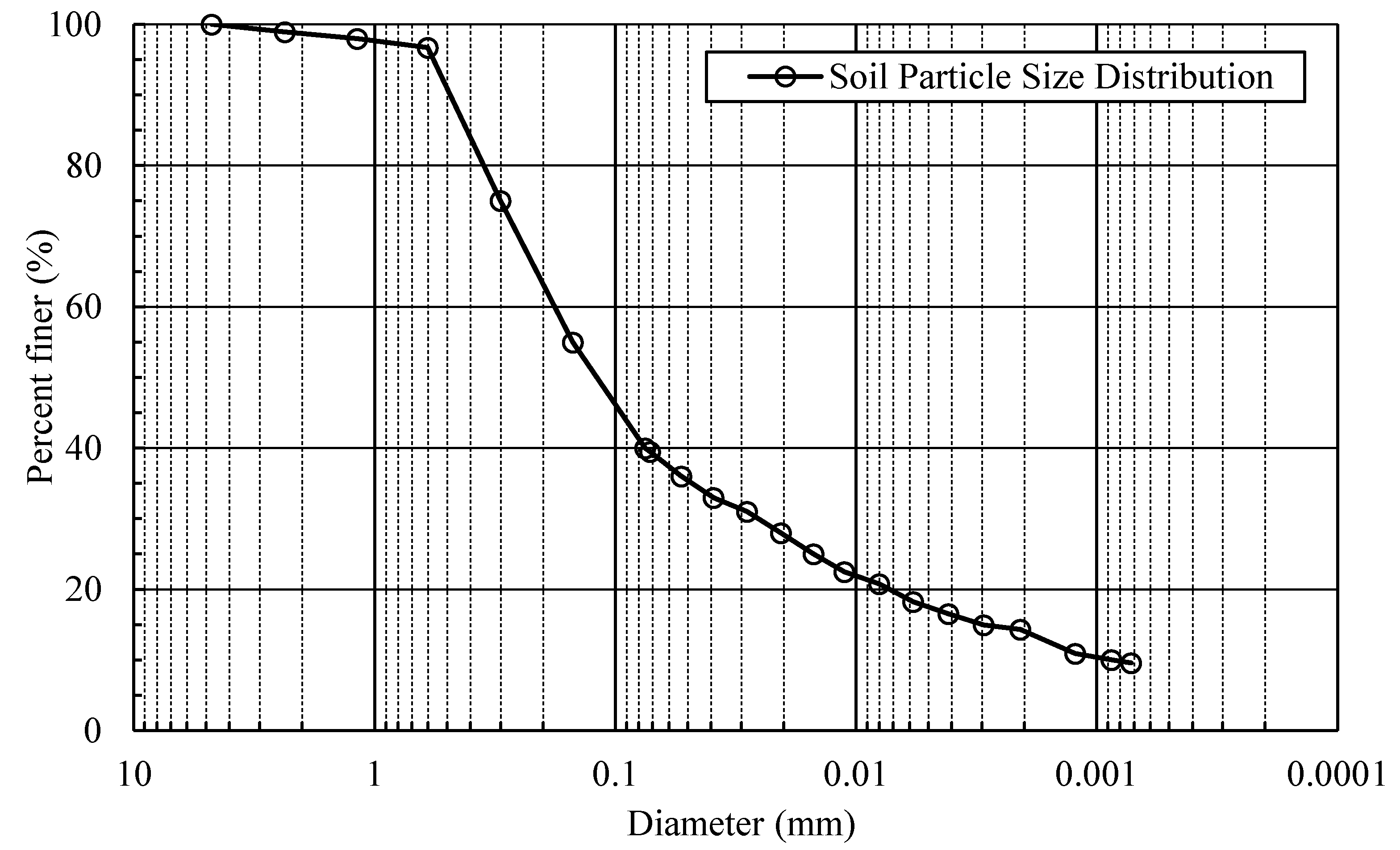
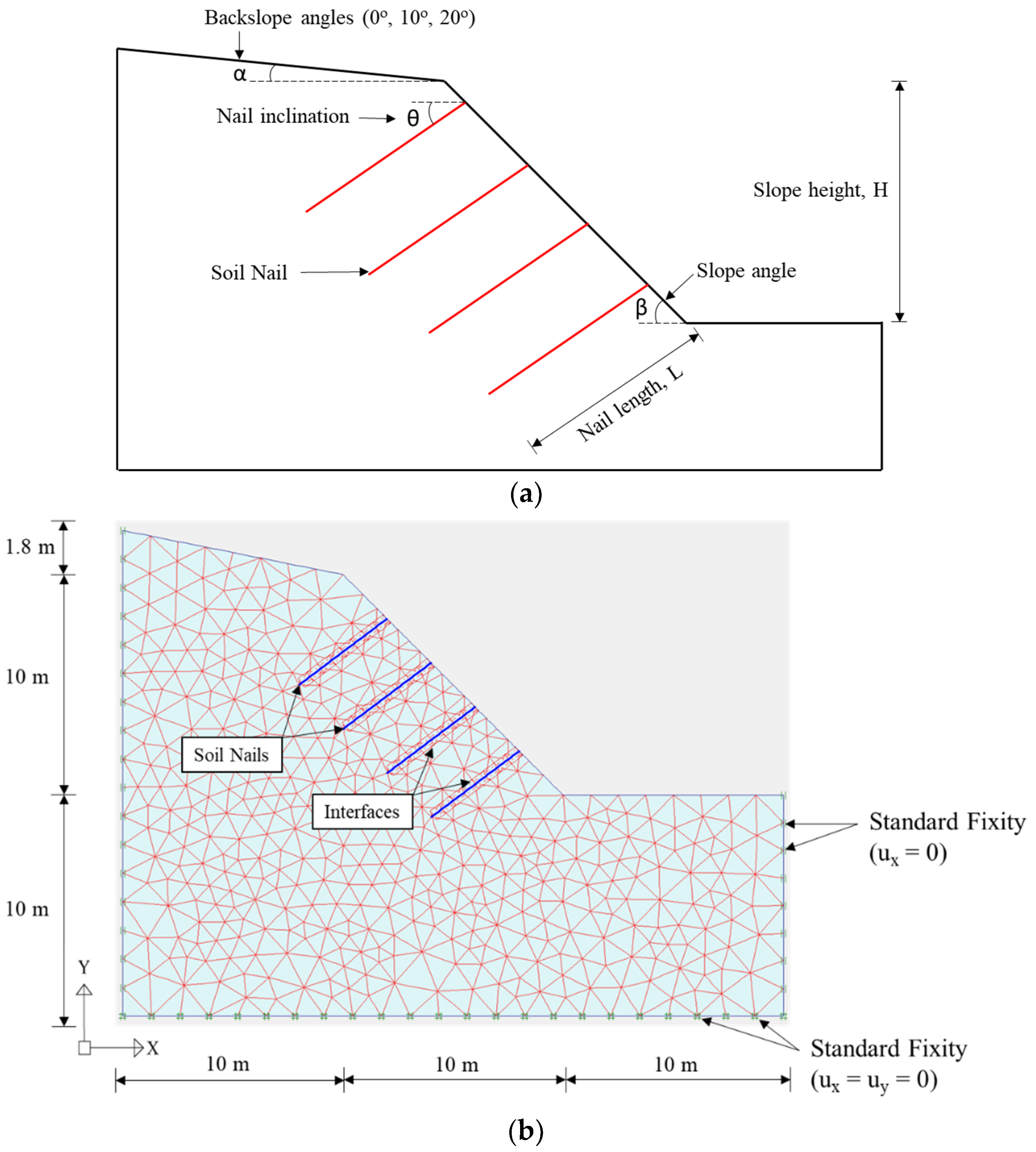
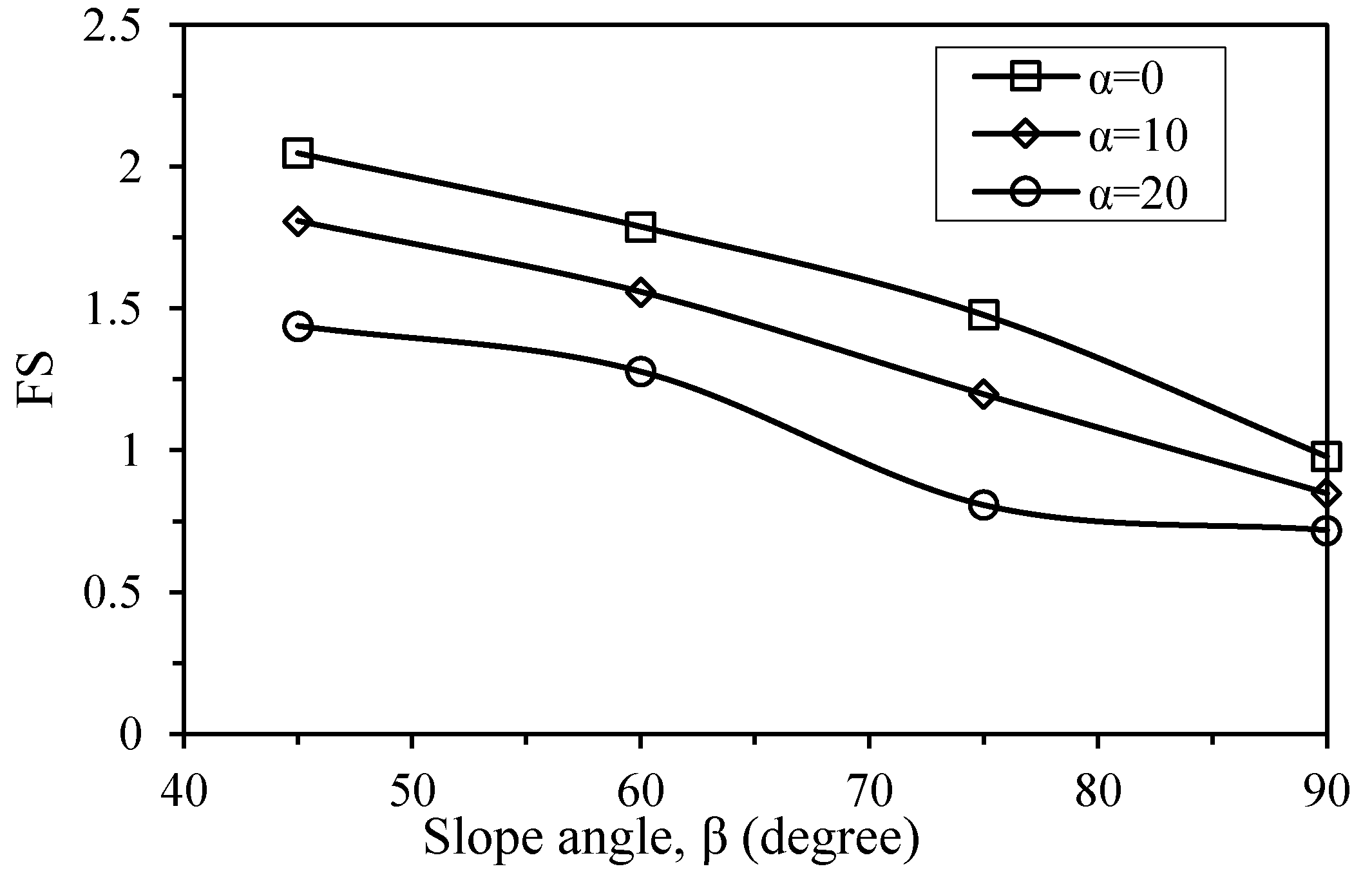
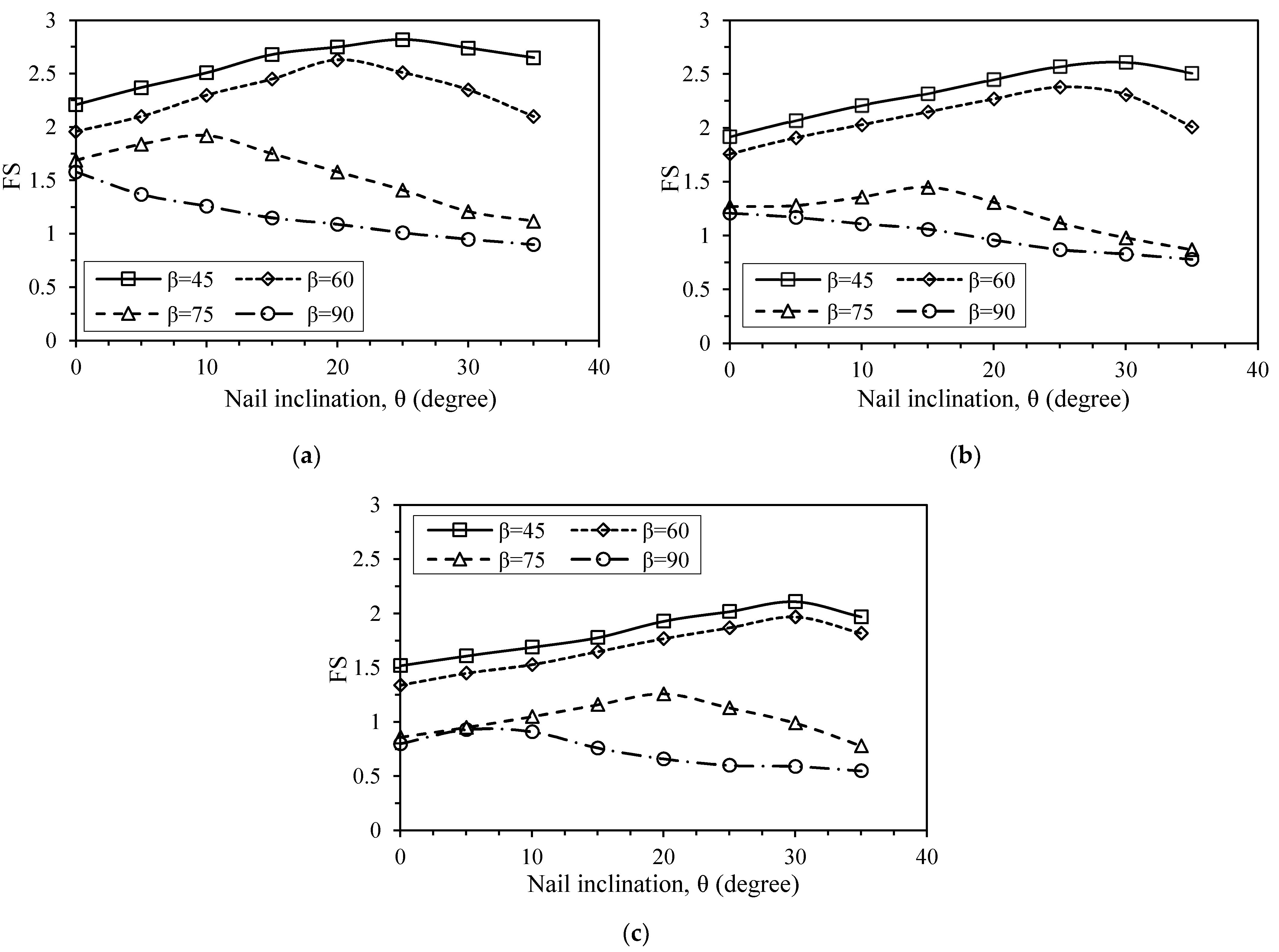
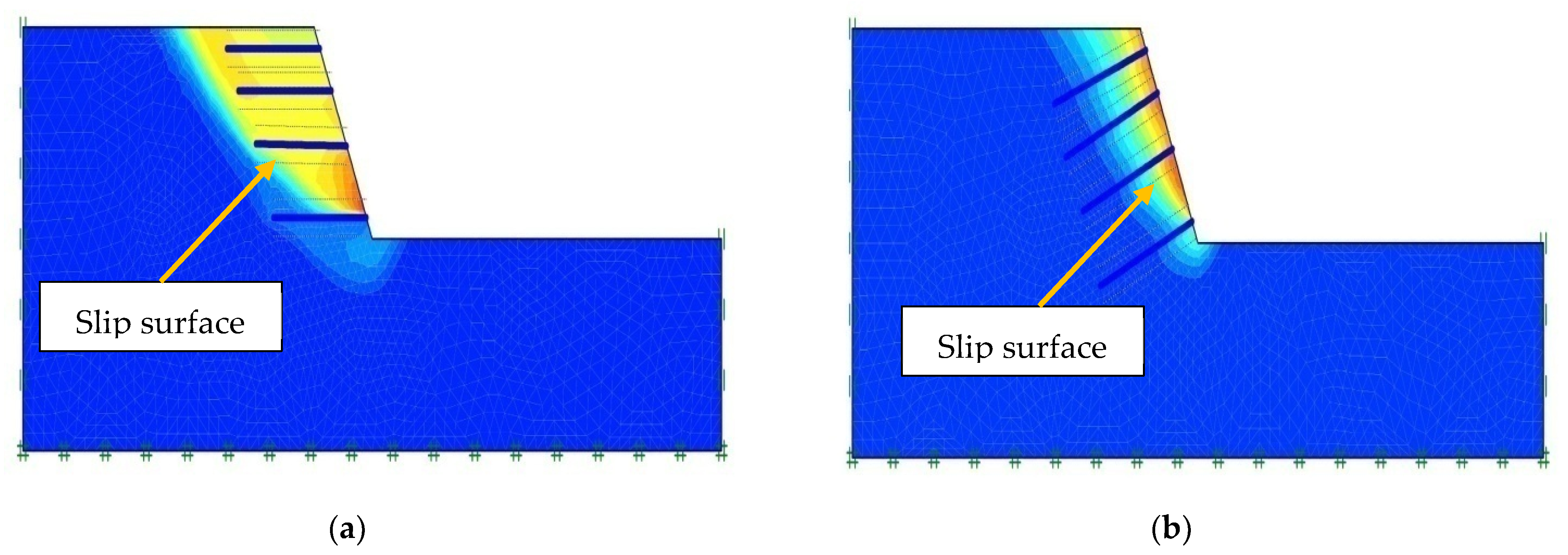

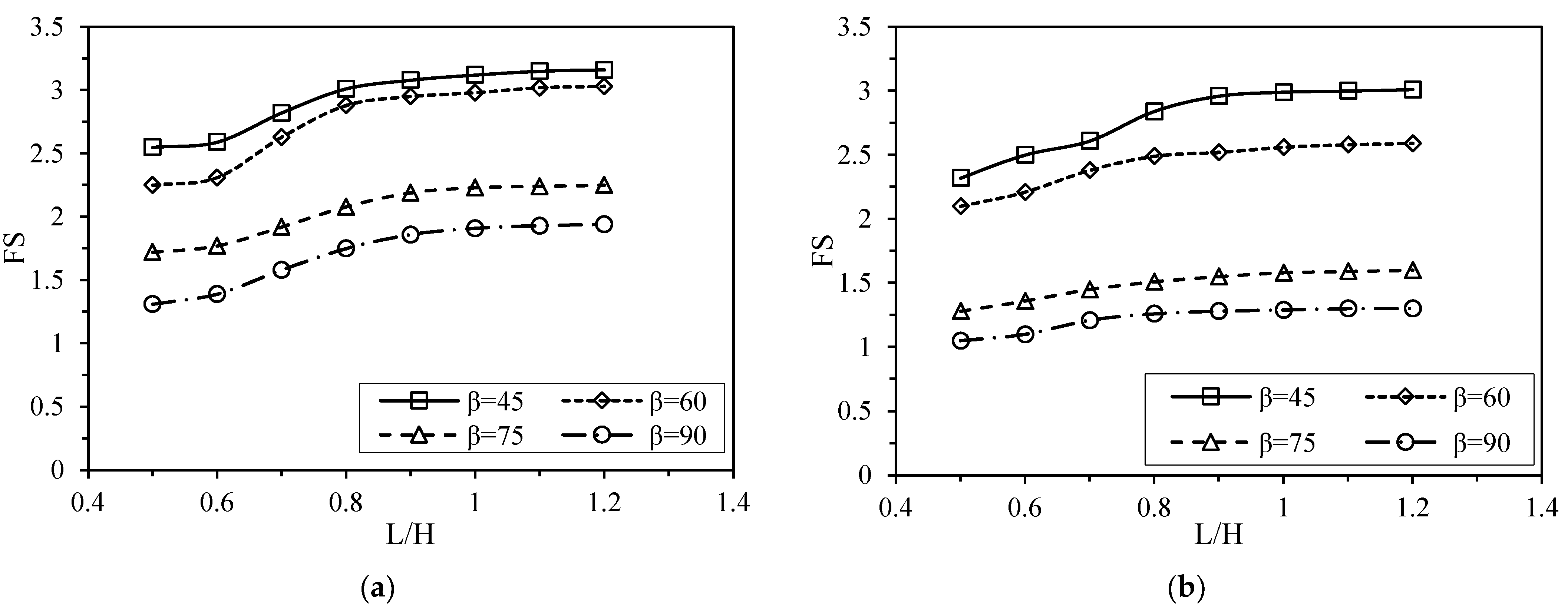

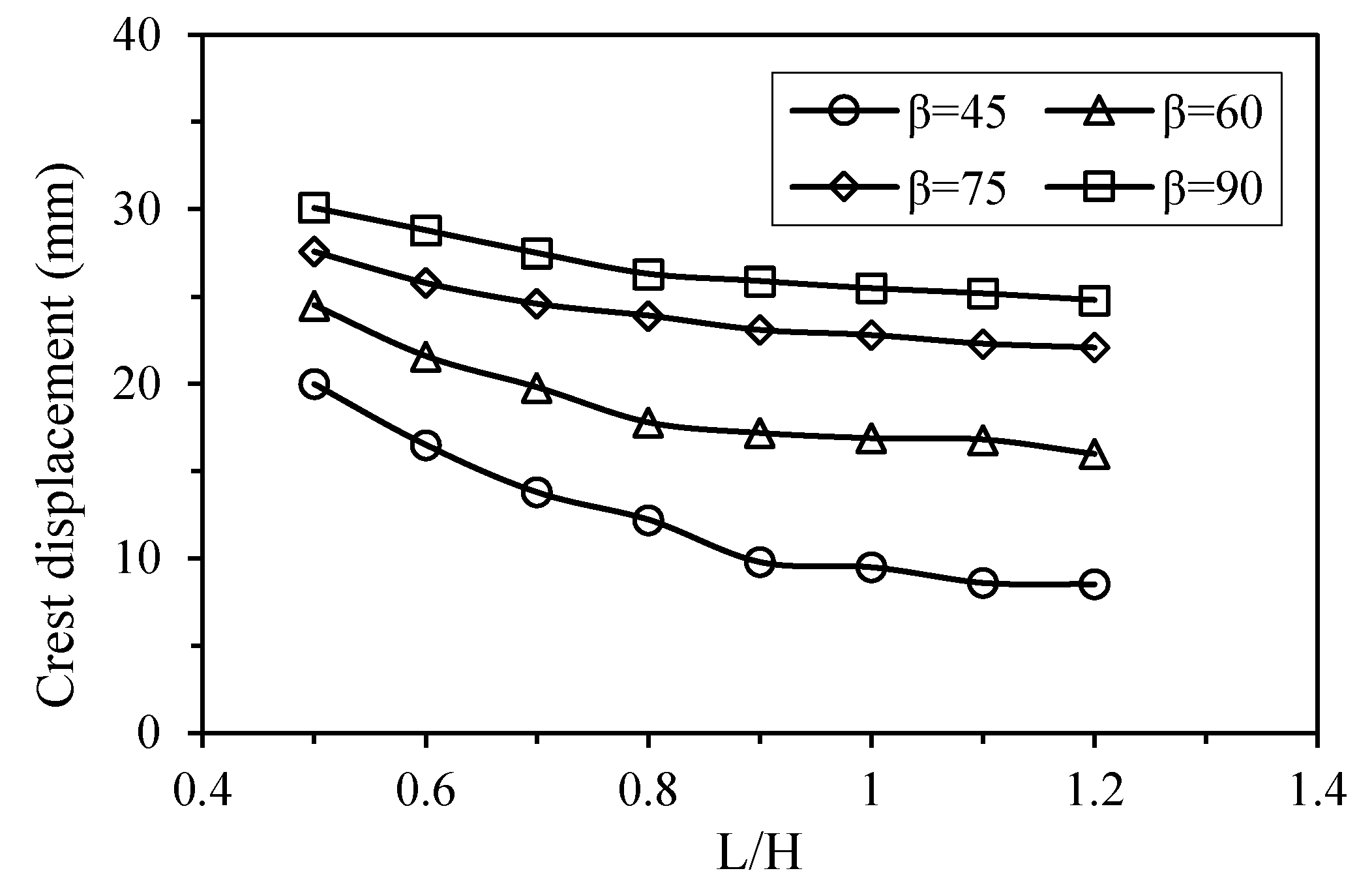

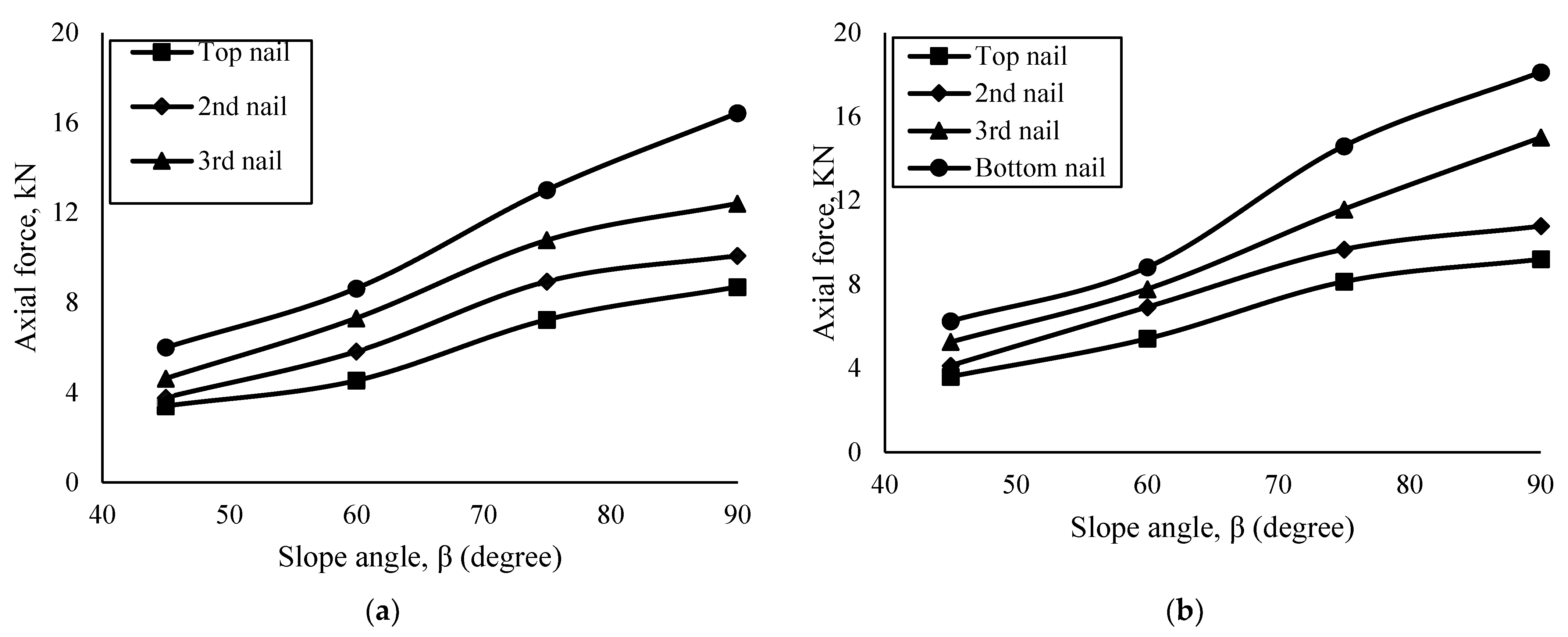
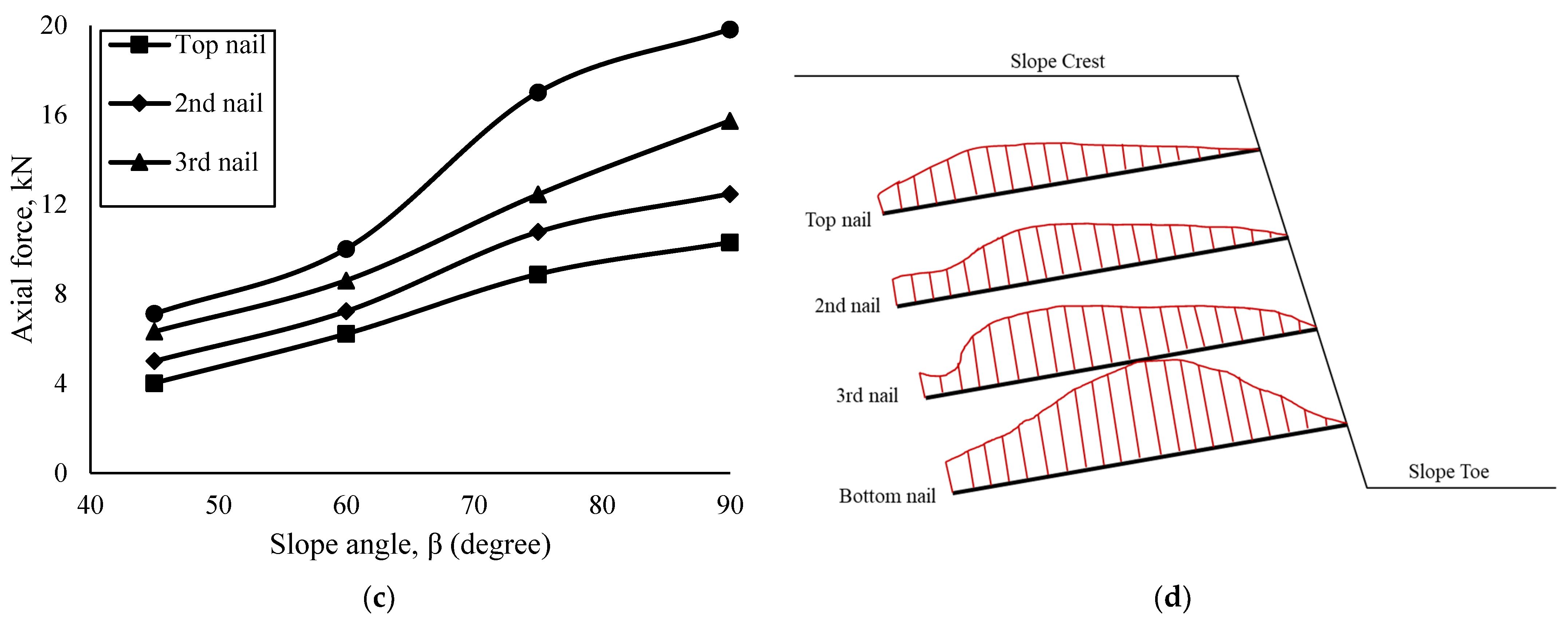
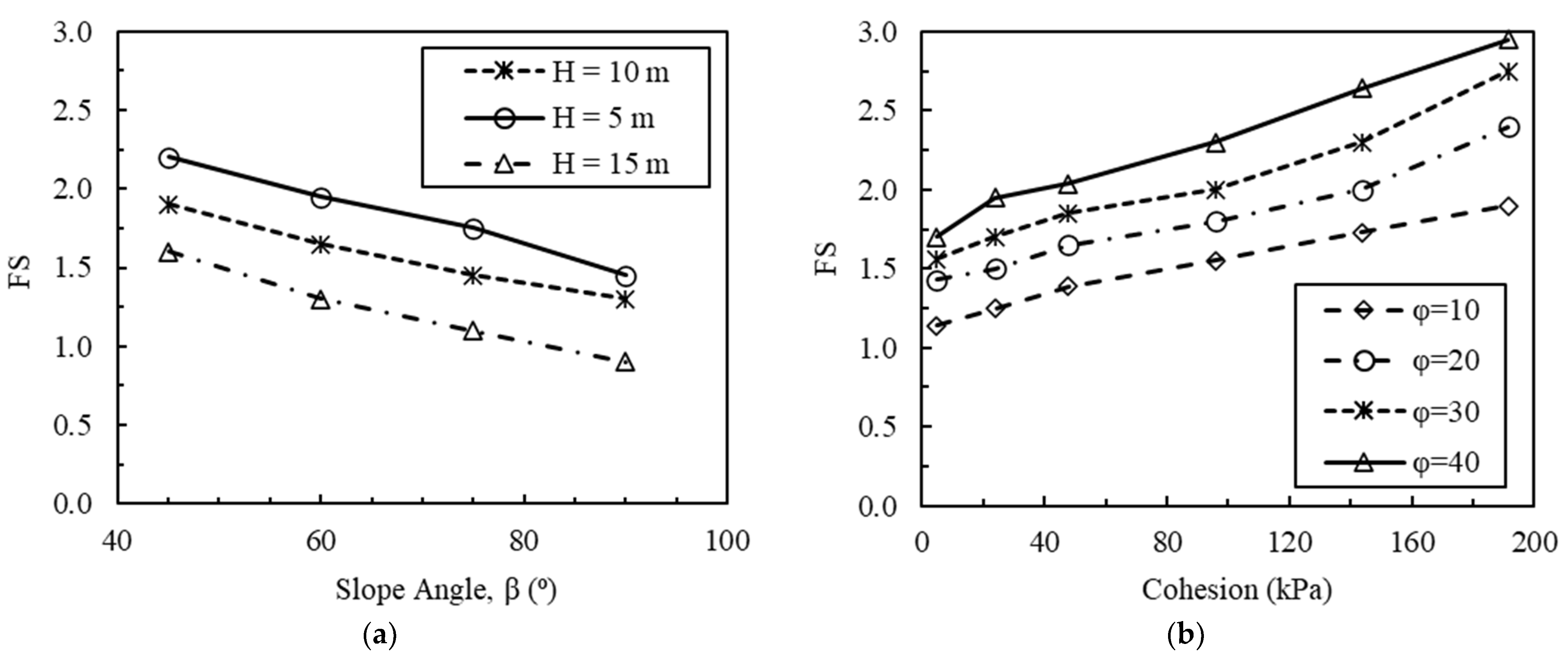
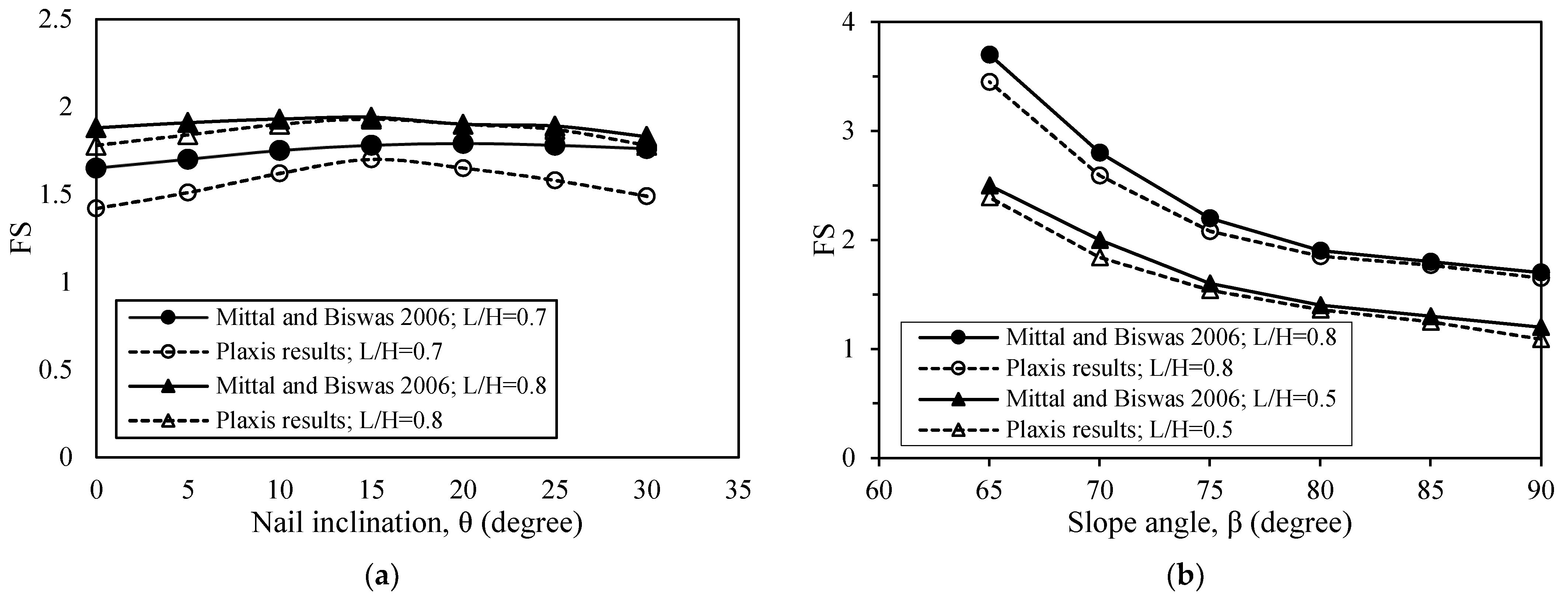
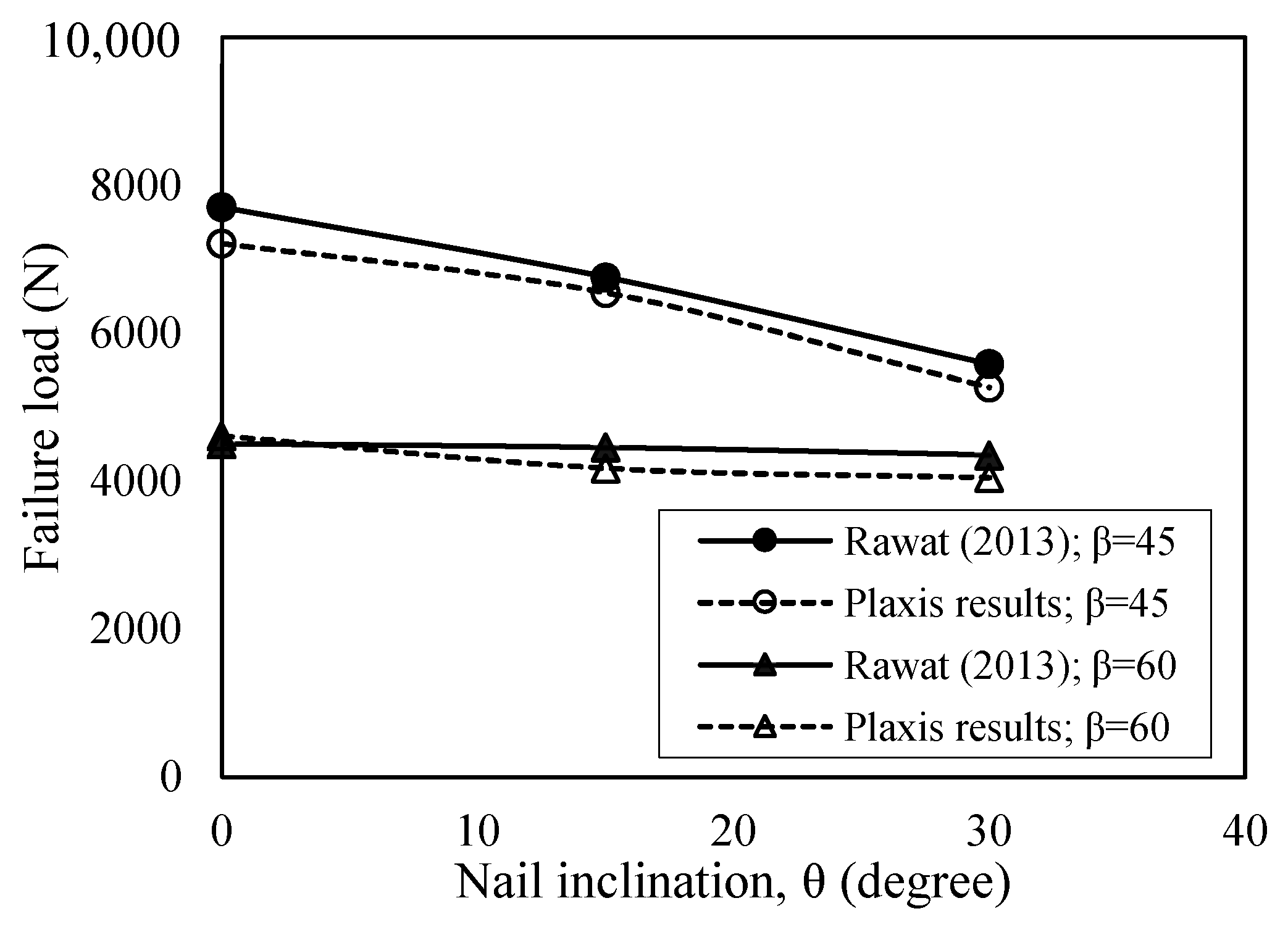

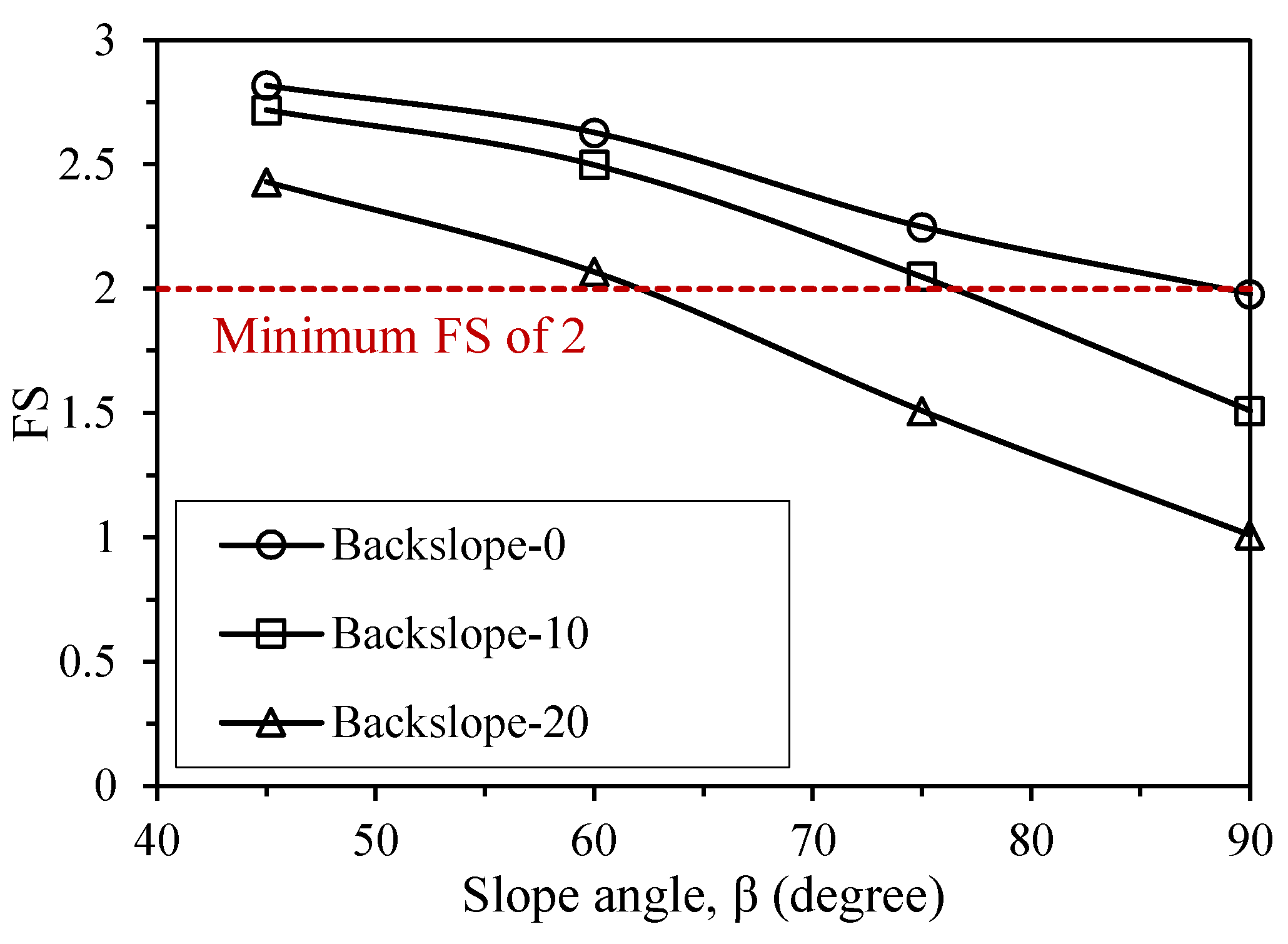
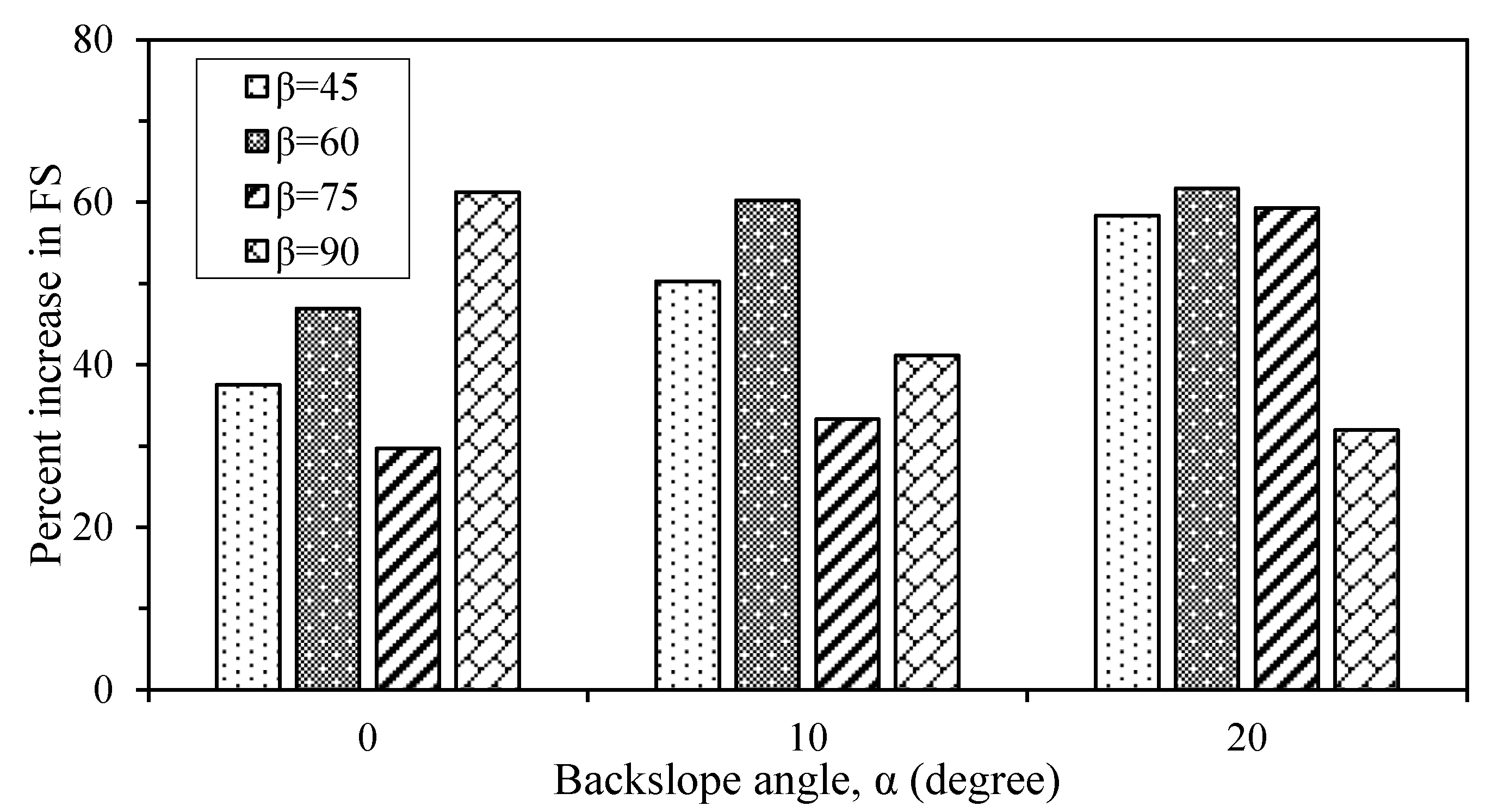
| Property | Parameter | Soil A |
|---|---|---|
| Specific gravity | Specific gravity, GS | 2.69 |
| Grain size distribution | Effective particle size, d10 (mm) | 0.004 |
| Average particle size, d50 (mm) | 0.075 | |
| Atterberg limits | Liquid limit, LL (%) | 35 |
| Plastic limit, PL (%) | 25 | |
| Plasticity index, PI (%) | 10 | |
| Shear strength parameters | Cohesion, c (kPa) | 10 |
| Angle of internal friction, φ (°) | 35 | |
| Modulus of elasticity, E (MPa) | 25 | |
| Soil classification | Unified soil classification system (USCS) | SC |
| Unit weight | Dry unit weight, γdry (kN/m3) | 16.7 |
| Saturated unit weight, γsat (kN/m3) | 19.0 |
| Parameter | Value |
|---|---|
| Nail element | Elastic Plate |
| (kN/m) | 105 |
| (kN m2/m) | 181.4 |
| Poisson’s ratio, ν | 0.3 |
| (°) | 0 |
| Interface thickness, δinter | 0.1 |
| Interface strength, Rinter | 1.0 |
| Modulus of elasticity of nail (GPa) * | 200 |
| Modulus of elasticity of grout (GPa) * | 22 |
| Slope Angle, β (°) | % Increase in FS for L/H (0.6~0.9) | % Increase in FS for L/H (0.9~1.2) |
|---|---|---|
| 45 | 18.9 | 2.6 |
| 60 | 23.7 | 2.7 |
| 75 | 27.7 | 2.7 |
| 90 | 33.8 | 4.3 |
| Parameter | Value | Unit |
|---|---|---|
| Material model | Mohr–Coulomb | - |
| Type of material behavior | Drained | - |
| Unit weight of soil above the phreatic line | 14.18 | kN/m3 |
| Unit weight of soil below the phreatic line | 18.79 | kN/m3 |
| Young’s modulus, E | 50,000 | kN/m2 |
| Cohesion, c | 5.44 | kN/m2 |
| Angle of internal friction, φ | 37.0 | ° |
| Outer diameter of nail | 8 | mm |
| Inner diameter of nail | 3 | mm |
| Length of nail | 240 | mm |
Publisher’s Note: MDPI stays neutral with regard to jurisdictional claims in published maps and institutional affiliations. |
© 2022 by the authors. Licensee MDPI, Basel, Switzerland. This article is an open access article distributed under the terms and conditions of the Creative Commons Attribution (CC BY) license (https://creativecommons.org/licenses/by/4.0/).
Share and Cite
Elahi, T.E.; Islam, M.A.; Islam, M.S. Parametric Assessment of Soil Nailing on the Stability of Slopes Using Numerical Approach. Geotechnics 2022, 2, 615-634. https://doi.org/10.3390/geotechnics2030030
Elahi TE, Islam MA, Islam MS. Parametric Assessment of Soil Nailing on the Stability of Slopes Using Numerical Approach. Geotechnics. 2022; 2(3):615-634. https://doi.org/10.3390/geotechnics2030030
Chicago/Turabian StyleElahi, Tausif E, Md Azijul Islam, and Mohammad Shariful Islam. 2022. "Parametric Assessment of Soil Nailing on the Stability of Slopes Using Numerical Approach" Geotechnics 2, no. 3: 615-634. https://doi.org/10.3390/geotechnics2030030
APA StyleElahi, T. E., Islam, M. A., & Islam, M. S. (2022). Parametric Assessment of Soil Nailing on the Stability of Slopes Using Numerical Approach. Geotechnics, 2(3), 615-634. https://doi.org/10.3390/geotechnics2030030






